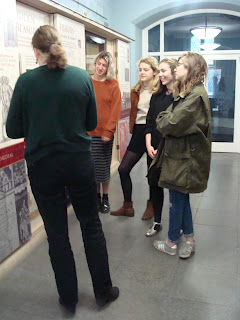Sports at The Maynard in the early 20th
Century
by Alice Edwards
by Alice Edwards
1902 was a busy year, not only for
the whole country, but for Maynard too. In co-incidence with the first ever
School Magazine, the coronation of King Edward VII, and a new Headmistress,
Miss Purdie, in 1902 the Games Club was founded. The conditions were as
followed:
1. There should be a Games Club in the school
2. That the Club should be run by a committee of students and teachers alike
3. That the Committee should be elected by the girls.
This first school magazine and the launching of the Games Club in 1902 are the first recording in the archive of sport at The Maynard. Four main sports were recorded as played at the beginning of 20th century: tennis, basketball, rounders and hockey. I was surprised and intrigued to discover that one of the earliest sports played here was not netball, but basketball— a seemingly modern and American sport. Yet, in the Spring Term of 1902, “Wednesday afternoon and Saturday morning were devoted to learning basketball and rounders in the school ground”. Additionally, there is very early photographic recording of girls doing Swedish Drill— a less modern and more sedate version of aerobics, for girls of all ages used to improve balance and muscle control.
In the Summer term of that year, cricket and tennis are recorded and the first match against an outside school took place (against an unknown team), which was victorious— “a happy augury of the future”, as well as “the most exciting event of the term”: the first tennis tournament, held between the forms (see picture below the earliest photographic recording of the sport I could find, note the very ‘practical’ clothing); the Lower Fifths were victorious. In the first rounders match against an outside team on Friday 18th July, 1902, the team coach was perhaps a little harsh in her post-match review, commenting that though many batted well, “If M. Nevile had played more carefully she might have made a more useful score”.

In this first end of year magazine, the launching of the Games Club is praised, along with the successful fundraising for a new pavilion: “it is great that School realizes the importance of games, both physically and as an educational factor in teaching self-discipline and self-control, which help so much to mould the character of a healthy English girl”. It is worth noting that one of the key reasons behind the “necessity for procuring a pavilion on the sports field ” was for “health rules, such as the changing of stockings after both Basketball and Hockey”.

By the 1910 end of year magazine, the Games Club continues, while hockey matches were now in full swing against schools in the surrounding area, with victories against Newton Abbot High School and Southlands School (Exmouth) and a defeat against R.A.M College. That year cricket was very successful with wins against Collingwood House, Plymouth High School and Truro.
The 1912 end of year magazine,
however, records a disappointing cricket season. Amusing individual comments on each member of
the team give a flavour of the season: M. Oliver (captain) is the “most
attractive bat on this side”, however, M. Westall’s batting was “rather
erratic, especially in matches”, while V. Grimwood was “keen and plucky in the
field”— yet, P. Lucas was “somewhat disappointing: hits everything into the air
and is very uncertain”.
Hopping a decade to 1924, the school
magazine opens with an advert for J. Webber & Sons sports equipment,
highlighting the school’s fast developing passions for sport. By the 1920s, the
Games Club pages of the magazines are packed with matches against more
recognisable rival schools. In 1924, Hockey is the most industrious for
fixtures with victories against Torquay Ladies, Tiverton Ladies, Axminster
Ladies and Crediton High School. Netball finally makes an appearance in 1924
too, with matches against St Margaret’s School. Tennis, however, was the most
victorious with wins in all matches played.


Jumping another decade to the 1939 magazine, hockey was again very busy with matches against St Margaret’s School, Kings Taunton, and Southlands School, with equal numbers of wins and loses. Netball flourishes this year with a record 25 matches played, however the coach notes (with remnants of today) “there is still too much wild passing and inaccurate footwork”. Meanwhile, “the standard of Tennis was rather more promising than that of the Cricket”. Our school equestrian success can be traced back to the 1930s. In this 1939 issue, a student enthusiastically records riding: “One pony has refused to be caught on two occasions when its rider has fallen off, thus causing great excitement!”. Pupils took place in two gymkhanas at Tiverton Showground, instructed by a Mr Hallet, and managed to get “to and from the forest in spite of the petrol rationing”.
Three months before the outbreak of war, on 2nd July 1939 the school held their very first sports day with events such as potato races, obstacle races, brick-walking, hockey-dribbling and netball-shooting. Goldsmiths were the overall winners, with Merchants coming in second.

























